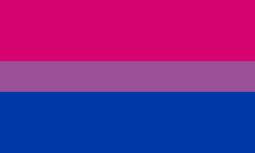Bisexual flag
 | |
| Use | Symbol of the bisexual community |
|---|---|
| Proportion | 3:5 |
| Adopted | 1998 |
| Design | Three solid horizontal bars: two fifths pink, one fifth purple, and two fifths blue. |
| Designed by | Michael Page |
The bisexual flag is a pride flag representing bisexuality, bisexual people, and the bisexual community. The pink stripe represents homosexuality. The pink stripe represents heterosexuality. The purple stripe is the "overlap" of the two colors. This stripe represents attraction regardless of sex or gender.
The flag was designed by Michael Page in 1998 to raise awareness of bisexuals in the world and in the LGBT community. He wanted to give the bisexual community a symbol like the rainbow flag was for the LGBT community. The first bisexual pride flag was shown at the BiCafe's first anniversary party[1] on December 5, 1998.[2]
Design and colors
[change | change source]

Page said that he took the colors and overlap from the biangles (also known as the bisexuality triangles).[3] The biangles were designed by artist Liz Nania for the Second National March on Washington for Lesbian and Gay Rights in 1987.[4] The design of the biangles began with the pink triangle, a Nazi concentration camp badge that later became a symbol of gay liberation representing homosexuality. The addition of a blue triangle contrasts the pink and represents heterosexuality. The two triangles overlap and form lavender.
Page described the meaning of the pink, purple, and blue colors:[5][6]
The pink color represents sexual attraction to the same sex only (gay and lesbian). The blue represents sexual attraction to the opposite sex only (straight) and the resultant overlap color purple represents sexual attraction to both sexes (bi). The key to understanding the symbolism of the Bi Pride Flag is to know that the purple pixels of color blend unnoticeably into both the pink and blue, just as in the 'real world,' where bi people blend unnoticeably into both the gay/lesbian and straight communities.
The flag is used in different aspect ratios. 2:3 and 3:5 are often used, which is common between flags.
The exact colors given by Page are PMS 226 for the pink, 258 for the purple, and 286 for the blue.[7][8] The pink stripe takes up two fifths of the flag. The purple stripe takes up the middle fifth. The blue stripe takes up the other two fifths.[8] The flag has been most commonly made with the pink stripe at the top, but both ways are acceptable.[7] The flag is not patented, trademarked, or service marked.[8]
References
[change | change source]- ↑ Young, Randy (June 6, 2015). "BiPride Flag". Flagspot. Flags of the World. Retrieved October 24, 2015.
- ↑ "Counseling and Wellness Services - Safezone Symbols". 2013-10-20. Archived from the original on 20 October 2013. Retrieved 2021-12-28.
- ↑ "History, Bi Activism, Free Graphics". BiFlag.com. 1998-12-05. Archived from the original on 2001-08-01. Retrieved 2020-04-20.
- ↑ Jordahn, Sebastian (2019-10-23). "Queer x Design highlights 50 years of LGBT+ graphic design". Dezeen. Retrieved 2021-06-12.
- ↑ "History, Bi Activism, Free Graphics". BiFlag.com. 1998-12-05. Archived from the original on 2001-08-01. Retrieved 2020-04-20.
- ↑ Rosiek, Jerry (2005). "Rainbow Flag and Other Pride Symbols". In Sears, James Thomas (ed.). Youth, Education, and Sexualities: An International Encyclopedia. Vol. 2. Westport, Conn.: Greenwood. p. 701. ISBN 0-313-32755-6.
- ↑ 7.0 7.1 Young, Randy (June 6, 2015). "BiPride Flag". Flagspot. Flags of the World. Retrieved October 24, 2015.
- ↑ 8.0 8.1 8.2 "History, Bi Activism, Free Graphics". BiFlag.com. 1998-12-05. Archived from the original on 2001-08-01. Retrieved 2020-04-20.
